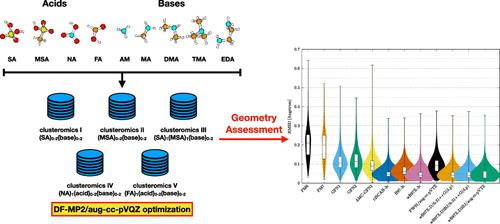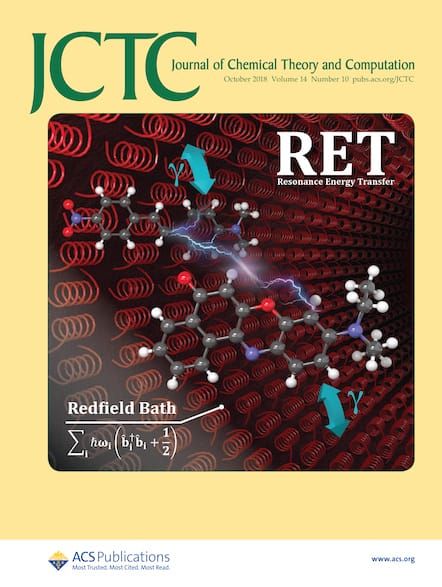Massive Assessment of the Geometries of Atmospheric Molecular Clusters
IF 5.5
1区 化学
Q2 CHEMISTRY, PHYSICAL
引用次数: 0
Abstract
Atmospheric molecular clusters are important for the formation of new aerosol particles in the air. However, current experimental techniques are not able to yield direct insight into the cluster geometries. This implies that to date there is limited information about how accurately the applied computational methods depict the cluster structures. Here we massively benchmark the molecular geometries of atmospheric molecular clusters. We initially assessed how well different DF-MP2 approaches reproduce the geometries of 45 dimer clusters obtained at a high DF-CCSD(T)-F12b/cc-pVDZ-F12 level of theory. Based on the results, we find that the DF-MP2/aug-cc-pVQZ level of theory best resembles the DF-CCSD(T)-F12b/cc-pVDZ-F12 reference level. We subsequently optimized 1283 acid–base cluster structures (up to tetramers) at the DF-MP2/aug-cc-pVQZ level of theory and assessed how more approximate methods reproduce the geometries. Out of the tested semiempirical methods, we find that the newly parametrized atmospheric molecular cluster extended tight binding method (AMC-xTB) is most reliable for locating the correct lowest energy configuration and yields the lowest root mean square deviation (RMSD) compared to the reference level. In addition, we find that the DFT-3c methods show similar performance as the usually employed ωB97X-D/6-31++G(d,p) level of theory at a potentially reduced computational cost. This suggests that these methods could prove to be valuable for large-scale screening of cluster structures in the future.

大气分子簇几何学的大规模评估
大气分子团簇对于空气中新气溶胶粒子的形成非常重要。然而,目前的实验技术无法直接洞察团簇的几何结构。这意味着迄今为止,关于应用计算方法如何准确描述团簇结构的信息非常有限。在这里,我们对大气分子簇的分子几何结构进行了大规模基准测试。我们首先评估了不同的 DF-MP2 方法在多大程度上再现了在高 DF-CCSD(T)-F12b/cc-pVDZ-F12 理论水平下获得的 45 个二聚体簇的几何结构。根据这些结果,我们发现 DF-MP2/aug-cc-pVQZ 理论水平最接近 DF-CCSD(T)-F12b/cc-pVDZ-F12 参考水平。随后,我们在 DF-MP2/aug-cc-pVQZ 理论水平上优化了 1283 个酸碱簇结构(最多为四聚体),并评估了更近似的方法如何再现几何结构。在测试的半经验方法中,我们发现新参数化的大气分子簇扩展紧密结合方法(AMC-xTB)在定位正确的最低能量构型方面最为可靠,与参考水平相比产生的均方根偏差(RMSD)最小。此外,我们还发现 DFT-3c 方法与通常采用的 ωB97X-D/6-31++G(d,p) 理论水平性能相似,但计算成本可能更低。这表明,这些方法在未来大规模筛选团簇结构时可能会很有价值。
本文章由计算机程序翻译,如有差异,请以英文原文为准。
求助全文
约1分钟内获得全文
求助全文
来源期刊

Journal of Chemical Theory and Computation
化学-物理:原子、分子和化学物理
CiteScore
9.90
自引率
16.40%
发文量
568
审稿时长
1 months
期刊介绍:
The Journal of Chemical Theory and Computation invites new and original contributions with the understanding that, if accepted, they will not be published elsewhere. Papers reporting new theories, methodology, and/or important applications in quantum electronic structure, molecular dynamics, and statistical mechanics are appropriate for submission to this Journal. Specific topics include advances in or applications of ab initio quantum mechanics, density functional theory, design and properties of new materials, surface science, Monte Carlo simulations, solvation models, QM/MM calculations, biomolecular structure prediction, and molecular dynamics in the broadest sense including gas-phase dynamics, ab initio dynamics, biomolecular dynamics, and protein folding. The Journal does not consider papers that are straightforward applications of known methods including DFT and molecular dynamics. The Journal favors submissions that include advances in theory or methodology with applications to compelling problems.
 求助内容:
求助内容: 应助结果提醒方式:
应助结果提醒方式:


